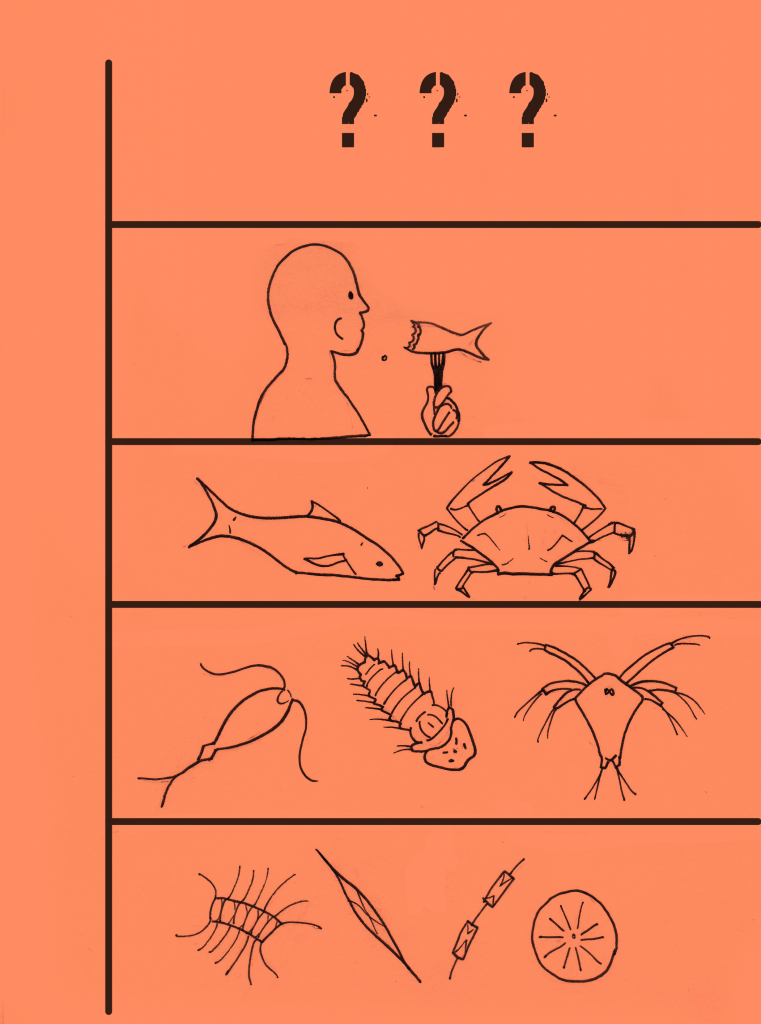By Emiliano Quale
Taxonomy
Class – Polychaeta
Phylum – Annelida
Kingdom – Animalia
Characteristics
The Larva of planktonic Annelids are known as trocophore, which are translucent, motile zooplankton characteristic of the class Polychaeta, as well as most Mollusk species. Being marine worms, Polychaete trocophore are found in oceans around the planet, and are especially abundant among coastal plankton populations. In the planktonic stage, they feed on phytoplankton, and are themselves eaten by larger nekton organisms.
Biology
Early-stage Polychaete trocophore larvae are pear-shaped, typically 300um in approximate size, and circumscribed by a ring of hair-like cilia, known as the prototroch. The prototroch enables motility in the water column, as well as collecting food particles suspended in the water column. The head above the prototroch contains a sensory plate, a median eye, and an apical tuft of cilia. The space below the prototroch contains the mouth stomach and anus, the latter surrounded by a perianal band known as the telotroch, which also aids motility.
The trocophore may be divided into three regions: the pretrochal region comprises the mouth area. The area containing the telotroch and anus is known as the pygidium region. The space between the mouth and prototroch is called the growth zone, which forms all the trunk segments. As tissue proliferates in the growth zone, the larva eventually outgrows planktonic existence, losing larval structures such as the ciliary bands. The other structures include the solenocyte, which balances the internal salinity of the organism.
Metamorphosis & Ecology
In later trocophoric stages, the worm’s body elongates, gaining additional posterior-facing segments behind the head. Each body segment along the trunk bears a pair of fleshy protrusions, called parapodia, each tufted with bristles called setae (a glucose derivative). The completed larval digestive tract includes a stomodaeum (oral), stomach, intestine and proctodaeum (anal).
The adult forms of polychaet worms are dominantly benthic organisms, with over 10,000 species so far discovered. The adults typically inhabit estuaries and subtidal zones, with some species inhabiting muddy intertidal zones, where they carry out the important function of sediment bioturbation in soft-bottoms, providing sediment stability and respiration. Some species of adult Polychaete worms continue to live among plankton. Polychaete worms reproduce sexually, typically releasing their eggs and sperm into the water column to for fertilization and producing trocosphore.
Polychaete Larva as metaphor
For 21st century humans, the larva of Polychaete worms may be seen as a support structure. It’s presence is a vital part of the diet of many marine species, which are themselves the dietary support for coastal human populations. In this way, the polychaete worm not only sustains itself from the available resources in its habitat, but also directly makes a valuable contribution back to its ecosystem. As humans, we consume our habitat for sustenance, but for the most part we do not give back to our habitat. In many ways, we have a deleterious effect on our environment. The planetary food web and most of the biosphere’s resources are funneled directly into the oblivion of human consumption, with little to no upkeep for the ecosystems we exist in. As evidenced by the collapse of many natural systems in the biosphere, and the short-circuiting of carbon cycling, it is clear that we need to devise ways to support our habitat, so that we are part of the support structure for the planet‘s biota, and not simply a parasite.
References
- “Structure and Significance of Trochophore Larva.” BiologyToday.com. N.p., 10 Nov. 2012. Web. 17 Nov. 2015. <http://www.biology-today.com/general-zoology/structure-and-significance-of-trochophore-larva/>.
- “Annelida: Class Polychaeta.” Infoplease.com. The Columbia Electronic Encyclopedia, 6th Ed. Columbia University Press, 2012. Web. 17 Nov. 2015. <http://www.infoplease.com/encyclopedia/science/annelida-class-polychaeta.html>.
- “Polychaetes: The Marine Worm” Lim Yun Ping. National University of Singapore, n.d. Web. 17 Nov. 2015. <http://lkcnhm.nus.edu.sg/polychaete/Introworms.html>.
- Perry, Robert. “”A Guide to the Marine Plankton of Southern California”” OceanGlobe 3rd ser. (2003): pages 14-15. UCLA Marine Science Center, 2003. Web. Nov. 2015. <http://www.msc.ucla.edu/oceanglobe/pdf/guide_plankton1.pdf>.
- “Trochophore | Larva.” Encyclopedia Britannica Online. Encyclopedia Britannica, 2015. Web. 19 Nov. 2015. <http://www.britannica.com/science/trochophore>.
Copyright – Emiliano Quale – 2015





1 Pingback